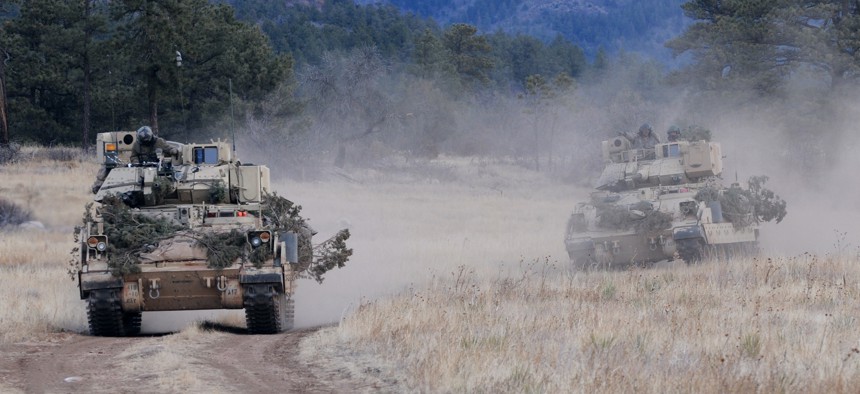
Soldiers from the U.S. Army's 4th Infantry Division drive their M3A3 Bradley Fighting Vehicles to reach a phase line where they will move into a defensive posture during platoon scout training near Fort Carson’s Camp Red Devil, Jan. 26, 2013. U.S. Army / Staff Sgt. Andrew Porch
How Artificial Intelligence Could Keep US Army Vehicles Ready for Action
A yearlong pilot program will see if AI can predict when components on Bradley Fighting Vehicles will break.
Going into combat is difficult enough as it is and the last thing you want on the battlefield is to have your equipment break down, especially something as critical as the vehicle that’s getting you around.
That’s why the U.S. Army spends millions of dollars every year making sure its infantry vehicles are ready for action. And officials think artificial intelligence could make maintenance more effective by lowering costs and giving commanders a better understanding of their fleets.
Last month the Army kicked off a pilot program with Uptake, a Chicago-based industrial technology startup, to test whether the company’s AI-powered platform can predict when components on the M2A3 Bradley Fighting Vehicle will break down. If the program is successful, the Army could ultimately scale the technology to the thousands of Bradleys it operates across the globe.
“Maintenance costs are one of our biggest concerns in the military in regards to sustaining the fleet,” said Chief Warrant Officer Jason Sibley, who serves as a maintenance technical adviser for armored fighting vehicles. “We’re doing all that we can to ensure the military is being supported as best as possible … so given the opportunity we have to be able to save costs in regards to sustaining the fleet, [artificial intelligence] is definitely an opportunity we want to look at.”
Uptake in July won the $1 million contract through the Defense Innovation Unit, a Pentagon startup outreach program that was rebranded Thursday. Under the agreement, Uptake will deploy its software on 32 Bradleys stationed at Fort Hood in Texas and work to predict when future repairs are needed and optimize the timing of general maintenance.
The company’s software, which is already used by industrial giants like Caterpillar and Berkshire Hathaway Energy, crunches data from diagnostic computers onboard the Bradleys as well as information about prior maintenance to determine how specific parts perform over time, said Uptake Federal and Defense Director Trey Clark in a conversation with Nextgov.
The program can then compare that information with a trove of historic machine data and estimate how long a specific component will last and alert Army technicians when maintenance is needed.
It could also prevent the Army from doing unnecessary preventative maintenance work, saving time and money.
Today, the Army annually spends $58.6 million to operate and maintain its fleet of M2A3 Bradleys, according to data provided by Sibley. That breaks down to roughly $47,000 per vehicle, or about $160 for every mile driven.
Much of that cost stems from the rigorous maintenance standards the Army upholds. Every Bradley is subject to weekly maintenance checks, as well as more intrusive quarterly, semi-annual and annual inspections, Sibley told Nextgov. But using Uptake’s software, technicians could get a better idea of which components need changing out and which ones have more life left in them.
“What we don’t want to do is we don’t want to preemptively spend a lot of money changing out parts that could withhold [more use]” Sibley said. “We’re always looking at opportunities to determine and validate whether the amount of maintenance that we perform currently is what’s needed for the platform itself. Can [maintenance standards] be safely pushed out a little bit further?”
During the pilot, Uptake will only analyze a handful of the Bradley’s components, Sibley said. While he declined to estimate the potential savings Uptake’s AI would bring, he said the Army is particularly interested in its uses for “sophisticated electronics” and other high-cost items.
Beyond general maintenance, the software could also give commanders in the field an in-depth understanding of the strengths and weaknesses of the vehicles at their disposal.
Imagine a commander is planning a dangerous mission that requires three Bradleys, but they have 10 to choose from. Right now they would select vehicles based on intuition and potentially outdated information, Clark said, but with real-time diagnostic data, that commander could pick the ones that are truly the most prepared for battle.
“To be able to project [diagnostics] straight back to the commander and give him an operational view to make choices regarding his fleet, that’s definitely something that’s going to be new that we’re looking forward to,” Sibley said.
The pilot will conclude roughly one year from now, at which point the Army will assess whether to scale the program to cover more components or vehicles, he added.
NEXT STORY: Trump’s Secret War on Terror
